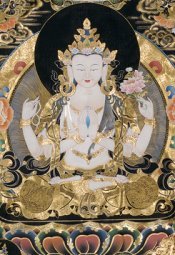Meditation

Bodhisattva Chenrezig
Our main focus as a group is to get together for regular meditation practice. Group practice provides inspiration and a supportive fellowship to help maintain our personal practice.
There are two main categories of meditation in Buddhism: Shamatha (also called calm abiding or tranquility meditation) and Vipassana (insight meditation).
Shamatha develops stable attention and provides the basis for investigating more subtle aspects of awareness. It helps to free the mind from disturbing emotions and unnecessary conceptual thinking to produce greater inner peace, harmony and balance.
Vipassana helps practitioners develop insight into the nature of reality to dispel the illusions that cause suffering. Shamatha by itself does not free us from delusion, but the stability generated from it combined with Vipassana can lead to freedom from delusion and hence freedom from suffering.
The cultivation of compassion and loving kindness is an essential companion to these practices.
The Kagyu tradition incorporates the creative methods known as Vajrayana that have been best preserved in Tibet. These practices provide a means to relate directly to the innate purity of the mind and the qualities that manifest from this primordial purity, using visualization, recitation of mantra and other methods.
Chenrezig Meditation
Following the example set by His Eminence Kalu Rinpoche in Western centres, our main meditation practice at this centre is the Chenrezig practice. It involves prayer, recitation, visualisation, and silent meditation. Chenrezig is the Tibetan name for the Bodhisattva of Compassion, known as Avalokiteshvara in Sanskrit.
Chenrezig practice is a complete practice that incorporates both shamatha and vipashana meditation, along with a strong emphasis on compassion. It is an efficient method of working towards enlightenment and well suited to our circumstances in the modern world.
Anyone can do this practice without becoming a Buddhist or obtaining special permission. When the opportunity arises, however, a practitioner should ideally receive the formal transmission of the practice from a qualified teacher.
A person joining us for Chenrezig practice is encouraged to participate at their own pace as it takes a little time to become familiar with the practice. The benefits of meditation are profound, but they are only realised with much patience. Introductory information is available and you will have opportunity to receive answers to your questions.
Ngondro Practice
With approval and appropriate instruction some practitioners may choose to do Ngondro (special foundational) practice, the pre-cursor to further training in Mahamudra meditation.
Further Reading
Click here to download a list of recommended reading, with further information on the above meditation practices as well as general informaiton on Buddhist philosophy and practice. The Links page lists websites where these resources can be purchased.
